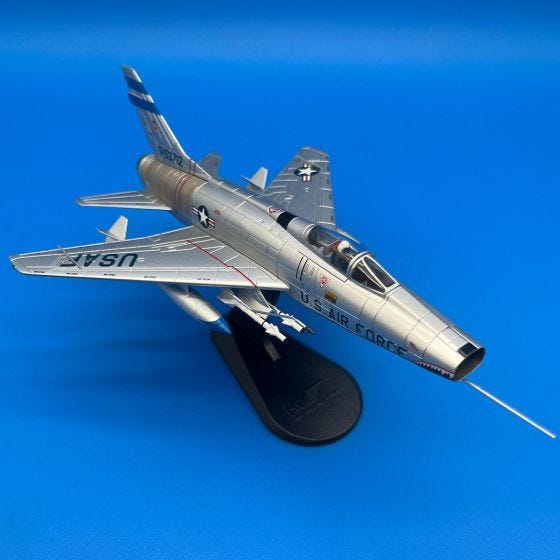F-100D Super Sabre “307th TFS” Die-Cast Model

In stock
Backordered
Precision made at 1:72 scale, this model is replicated from an F-100D that served in the 307th Tactical Fighter Squadron during Vietnam.
Beginning the “Century Series” line of aircraft, the North American F-100 was an advanced development from the F-86 Sabre. Operating in Vietnam during the 1960s, this F-100D was the primary fighter-bomber type for the 307th Tactical Fighter Squadron. Deployed against the North Vietnamese and National Liberation Front, they provided tactical air support for ground forces over several months. Following this deployment, they were replaced by the 308th TFS, with new assignment to Torrejon Air Base in Spain.
Features:
- High-quality livery with engraved panel lines, printed decals, antennas, and surface details
- Deployed or retracted landing gear
- Attachable press-fit weaponry
- Included display stand
- Opening cockpit with pilot figurine that can be placed inside
- Measures 7.75”l with a 6.5” wingspan at 1:72 scale
- Officially licensed
History and Specifications:
Powered by the Pratt & Whitney J57-P21 afterburning turbojet and featuring a 45-degree swept wing, the sleek new F-100 was prepared to attain speeds over 900mph. It was also designed to fly at high angles of attack, increasing dogfighting agility in combat. Flown by test pilot George Welch, it would exceed Mach 1 in on May 25th, 1953, making him the first pilot to surpass the speed of sound in level flight. Shortly the demonstration run, the USAF would order 275 of the type, including several prototypes to iron out the flaws. Following successive performance improvements, the F-100D was first delivered to the 405th Fighter Bomber Wing at Langley AFB during 1956. Boasting four M39A1 20mm autocannons and four AIM-9 Sidewinder air-to-air missiles in traditional combat configuration, it could also carry napalm, iron bombs, and AGM-12 Bullpup air-to-ground guided missiles. Though difficult to fly and plagued with systems issues across its lifespan, the Super Sabre had a great deal of impact on the 20th century USAF design.





